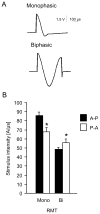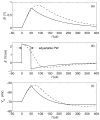Consensus: New methodologies for brain stimulation
- PMID: 20633398
- PMCID: PMC5507351
- DOI: 10.1016/j.brs.2008.09.007
Consensus: New methodologies for brain stimulation
Abstract
We briefly summarized several new stimulation techniques. There are many new methods of human brain stimulation, including modification of already known methods and brand-new methods. In this article, we focused on theta burst stimulation (TBS), repetitive monophasic pulse stimulation, paired- and quadri-pulse stimulation, transcranial alternating current stimulation (tACS), paired associative stimulation, controllable pulse shape TMS (cTMS), and deep-brain TMS. For every method, we summarized the state of the art and discussed issues that remain to be addressed.
Figures









References
-
- Kandel ER, Spencer WA. Electrophysiology of hippocampal neurons. II. After-potentials and repetitive firing. J Neurophysiol. 1961;24:243–259. - PubMed
-
- Huang YZ, Chen RS, Rothwell JC, Wen HY. The after-effect of human theta burst stimulation is NMDA receptor dependent. Clin Neurophysiol. 2007a;118:1028–1032. - PubMed
-
- Huang YZ, Edwards MJ, Rounis E, Bhatia KP, Rothwell JC. Theta burst stimulation of the human motor cortex. Neuron. 2005;45:201–206. - PubMed
-
- Huang YZ, Rothwell JC. Theta burst stimulation. Transcranial brain stimulation for treatment of psychiatric disorders. In: Marcolin MA, Padberg F, editors. Advances in biological psychiatry. Karger; 2007. pp. 187–203.
-
- Huang YZ, Rothwell JC, Edwards MJ, Chen RS. Effect of Physiological Activity on an NMDA-Dependent Form of Cortical Plasticity in Human. Cereb Cortex. 2007b - PubMed
Publication types
MeSH terms
Grants and funding
LinkOut - more resources
Full Text Sources
Medical

